I Had Roux and Y Gastric Bypass 15 Years Ago
Abstruse
Purpose
Since 2014, sleeve gastrectomy (SG) has been the about frequently performed bariatric-metabolic operation worldwide (2018: 386,096). In that location are only a few studies reporting a long-term follow-up (up to 11 years) available today. The aim of this study was to evaluate the long-term outcome of SG with a follow-upward of at least 15 years regarding weight loss, remission of associated medical problems (AMP), conversions, and quality of life (QOL).
Setting
Multicenter cross-sectional written report; academy hospital.
Methods
This written report includes all patients who had SG before 2005 at the participating bariatric centers. History of weight, AMP, conversions, and QOL were evaluated past interview at our bariatric center.
Results
L-three patients met the inclusion criteria of a minimal follow-up of fifteen years. Weight and body mass alphabetize at the time of the SG were 136.8kg and 48.7kg/mii. 20-six patients (49.i%) were converted to Roux-en-Y gastric bypass (RYGB) for weight regain and gastroesophageal reflux inside the follow-up period. Total weight loss after 15 years was 31.5% in the non-converted group and 32.9% in the converted group. Remission rates of AMP and QOL were stable over the follow-up period.
Decision
Fifteen years afterwards SG, a stable postoperative weight was observed at the price of a loftier conversion rate. Patients converted to RYGB were able to accomplish farther weight loss and preserve good remission rates of AMP. SG in patients without the need of a conversion to another bariatric-metabolic procedure may be considered constructive. Careful preoperative patient pick is mandatory when performing SG.
Graphical abstract
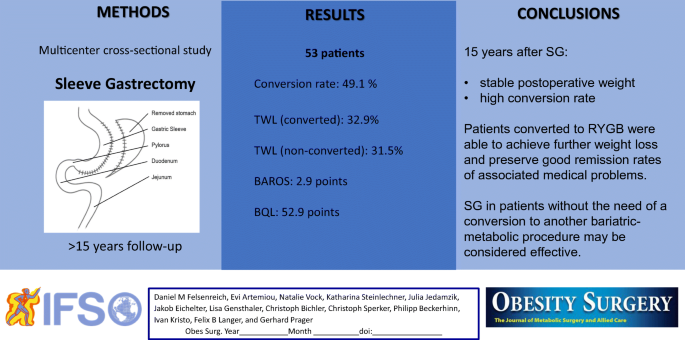
Background
Obesity is a disease that continually increases in numbers worldwide. Information technology is strongly associated with numerous medical bug of the metabolic syndrome [1]. Today, several bariatric/metabolic operations are available, and the number of performed procedures globally increases each twelvemonth [two]. Since 2014, sleeve gastrectomy (SG) has been the nigh frequently executed operation for patients with obesity worldwide. In 2018, 386,096 (55.4%) patients underwent SG [3].
In its outset, SG, a mainly restrictive operation which entails the resection of a greater part of the stomach, was a component of biliopancreatic diversion with duodenal switch [4]. Later, SG was mostly performed in patients with severe obesity (BMI >50kg/m2) as the start footstep of a two-step procedure. A second bariatric-metabolic process would be performed after initial weight loss [5]. Currently, SG is an accepted stand-lone bariatric-metabolic procedure for about patients with obesity [6].
Studies reporting a brusque-term follow-up after SG usually present good weight loss, remission of associated medical bug (AMP), and only low numbers of patients with weight regain (WR) and gastroesophageal reflux disease (GERD) [7]. In studies with a longer follow-up period, an increasing number of patients suffer from WR and GERD, some of them in demand of a conversion to another bariatric-metabolic functioning [8,9,10].
The efficacy of a bariatric-metabolic procedure may only truly exist evaluated at a long-term follow-up. However, there are just a few studies reporting a long-term follow-upwards (up to xi years) bachelor in the literature today [11, 12]. Thus, the aim of this study was to evaluate patients that received SG earlier 2005 with a follow-up of at least fifteen years in a multicenter setting. Assessed variables are the history of weight, remission of AMP, conversion to other bariatric-metabolic procedures, and the patients' quality of life (QOL).
Patients and Methods
All patients that underwent SG for obesity before December 2005 in one of three Austrian bariatric centers were included in this multicenter study. The participating centers were Medical Academy of Vienna, Hospital Rudolfstiftung in Vienna, and Hospital Klosterneuburg.
This study was canonical by the Review Board of the ethical commission of Medical University of Vienna (Reference number: 2169/2019). Informed consent was obtained from all participating patients.
Patient Cohort
The included collective represents a 15-twelvemonth follow-up of the aforementioned 53 patients reported past Felsenreich et al. in 2022 (10-twelvemonth follow-up after SG) [xiii]. Each patient had a preoperative gastroscopy ensuring that none of the included patients had Barrett'due south esophagus or hiatal hernia. Participants did not take symptomatic reflux either at the fourth dimension of the SG.
Patients who nevertheless have their SG after 15 years (non-converted patients), as well as patients who were converted inside the follow-upwardly catamenia, were interviewed on their history of weight, remission of AMP, and conversions to other bariatric-metabolic procedures. Additionally, not-converted patients were asked to complete the following questionnaires on the outcome subsequently bariatric-metabolic surgery and QOL: Bariatric Analysis and Reporting Effect Organisation (BAROS) [14], Bariatric Quality of Life Alphabetize (BQL) [fifteen, 16], and Brusque Form 36 (SF-36) [17].
To achieve a loftier follow-up rate, patients were contacted per telephone or postal service and called in for an interview. In Austria, the current home accost tin be caused from the registration offices for scientific reasons besides as data from the obituary column to avoid patients lost to follow-up. Data of deceased and acutely converted patients (within a short period of time later the SG) were included in the baseline characteristics but not in the farther calculation of the follow-up.
Surgical Technique
The technique of performing a SG (Fig. 1) was similar in the three bariatric centers participating in this study and will briefly be described in this chapter. Subsequently creating a capnoperitoneum with 12–15mmHg, the lesser sac was entered and opened from the pylorus to the bending of His at the greater curvature of the stomach while preserving the gastro-epiploic arcade. The sleeve's blood supply is ensured by the right and the left gastric arteries. The left crus of the hiatus was visualized to detect undiagnosed hiatal hernias. Any hiatal hernias detected during this step would accept been treated with hiatoplasty at this point. Yet, in this series, none of the patients had whatsoever hiatal hernia detected intraoperatively. And then, a 14–16mm (42–48 French) bougie was inserted to guide and standardize the resection of the stomach using five to seven stapler magazines. The starting signal was at about 6cm distance from the pylorus and stapling ended at the angle of His to resect the unabridged fundus. Belsey's fat pad was removed to increment the vision to the angle of His. The staple line was oversewn by a running suture.
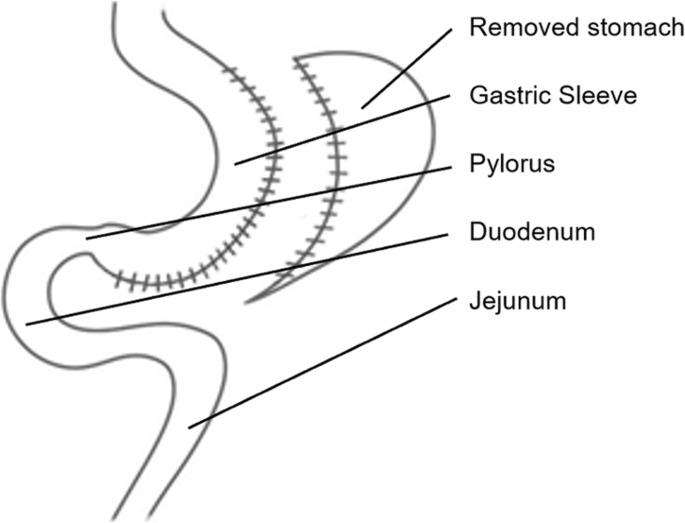
Sleeve gastrectomy
The technique of performing a SG mutual and then has only changed slightly upward until at present. The differences are that today, we use a slightly smaller bougie size of 12mm (36 French) and get-go the resection slightly closer to the antrum (ii–3cm from the pylorus). The complete resection of the entire fundus was performed then and is still done today [eighteen].
Weight Loss
Weight and BMI (body mass Index) at the time of the SG (besides as at the time of the conversion in converted patients) were gathered from operation protocols. Patients were asked for their nadir weight (including signal in fourth dimension when it was reached) after SG (and afterwards conversion, if applicable). Data on patients' ten-year postoperative weight was published in the above-mentioned publication for the same cohort [13]. Equally earlier, weight regain was divers as weight proceeds of >10kg from nadir weight [13]. Patients' current weight 15 years afterwards SG was determined by weighing them in our walk-in dispensary for standardized values from verified scales.
Conversion to Other Bariatric-Metabolic Procedures
All operation protocols and electronic patients' charts were studied to gather information about the reason for the conversion, body weight, status of AMP, etc.
Remission of Associated Medical Problems
The status of AMP at the time of the SG (equally well as at the time of the conversion in converted patients) was gathered from the operation protocols. The status of AMP at 10 years postoperative was published before [13], and for the current status 15 years after SG, patients were interviewed at our outpatient clinic. Remission or new onset of AMP was defined by an (discontinued/new) intake of illness-specific medication.
Quality of Life
The outcome of the SG and the QOL at the long-term follow-up were both evaluated using questionnaires (BAROS, BQL, and SF-36) only in non-converted patients.
BAROS is a validated tool to evaluate the outcome of bariatric-metabolic surgery. It consists of v categories (weight loss, comeback of AMP, QOL, complications, and reoperation) the consequence of which is classified equally failure, fair, expert, very good, or excellent [14].
The BQL is a user-friendly questionnaire to assemble information about patients' QOL later on bariatric-metabolic surgery. Information technology consists of 13 questions, with a maximum full score of 65 points. It creates a comprehensive film of patients' QOL in their daily routine [15, 16].
SF-36 is a validated general QOL score including 36 questions that represent patients' QOL in eight different categories that focus on physical (physical performance (PF), concrete part (RP), actual hurting (BP), full general health (GH)) and mental QOL (emotional role (RE), mental health (MH), vitality (VT), social operation (SF)) [17].
Statistical Analysis
The presentation of data in this study was as percentage, by mean and standard deviation (SD), or median and range (R). Comparing different groups of information, either non-parametric Isle of mann-Whitney U exam or chi-foursquare test was used. Univariate analysis was two-tailed with statistical significance defined as a p-value <0.05. Backlog weight loss (EWL) in % was calculated based on a BMI of 25kg/mtwo (upper limit of the ideal BMI). The number of participants included in this study was limited by the number of patients that were able to reach the follow-up of at least 15 years. Data was collected in Excel for Windows (Microsoft, Redmond, Washington, The states), and statistical calculations were performed using SPSS V24 for Windows (IBM Corporation, Armonk, NY, USA).
Results
Fifty-three patients received SG as a bariatric-metabolic procedure before December 2005 in any of the three participating centers, and, therefore, the follow-upward of this study is at to the lowest degree 180 months. The patients' characteristics are highlighted in Tabular array 1. Previous operations were adjustable gastric banding in 10 patients (18.ix%), gastric stimulation in i patient (one.nine%), and an endoscopic gastric balloon placement in one patient (1.nine%). 40-one patients (77.iii%) had SG as primary bariatric-metabolic process.
Four patients died inside the 15-year follow-up period; nevertheless, their deaths were not associated with whatever bariatric-metabolic surgical procedure. These 4 patients and 1 patient who was acutely converted for early leak were excluded from farther analysis in terms of weight loss and comeback of AMP. Another acutely converted patient, who is one of the iv deceased patients, died more than 12 years after the conversion.
A complete follow-upwards after xv years was attained in 46 of the remaining 48 patients (95.8%). The median follow-up period was 186 months (range 181–207 months) ≙fifteen.5 years.
Conversion Rate and Weight Loss
A total of 26 (49.1%) of 53 patients were converted: 25 to Roux-en-Y gastric bypass (RYGB) and one to biliopancreatic diversion with duodenal switch. The main indication for the conversion was WR in fourteen patients (26.4%), symptomatic GERD in ten patients (xviii.9%), and astute conversion for an early leak in two patients (3.8%); see Table one and Fig. 2. Twelve of the converted patients (46.two%) in fact suffered from both, WR and GERD.
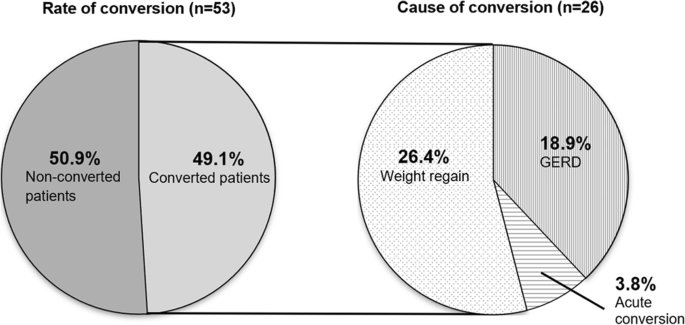
Conversion charge per unit and cause of conversion fifteen years after sleeve gastrectomy. Abbreviations: GERD gastroesophageal reflux disease
Hateful weight and BMI at the time of the SG were 136.8 ±27.8kg and 48.seven ±9.2kg/grand2. The history of weight within the 15-year follow-up period, excluding deceased and acutely converted patients, is presented in Table 2. The lowest postoperative weight and BMI these patients were able to reach subsequently a median of 12 months were 86.3 ±19.8kg/one thousand2 and 30.9 ±6.2kg/m2, representing a total weight loss (TWL) of 36.nine ±11.7.
Weight and BMI at the time of the conversion in the entire group of converted patients were 112.0 ±24.6kg and 38.4 ±vi.2kg/1000two afterwards a median menstruum of 48 months. After a follow-upwardly of 186 months, the non-converted group was able to accomplish a weight, BMI, and TWL of 93.0 ±22.1kg/mii, 34.3 ±6.9kg/m2, and 31.five ±12.6%. The weight, BMI, and TWL of the converted grouping was 91.6 ±19.3kg/m2, 31.v ±five.5kg/mii, and 32.9 ±xv.1%. A detailed history of weight in patients converted mainly due to reflux or weight regain is highlighted in Table 2. To highlight weight changes over fourth dimension, information from our previous publication based on a 10-year follow-up [13] was added to Table 2. The history of weight in non-converted patients over the menstruation of 15 years is highlighted in Fig. 3.
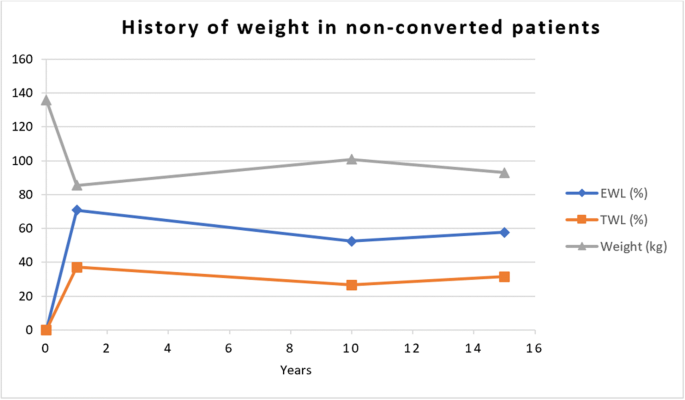
Weight, EWL, and TWL in non-converted patients over the fourth dimension period of 15 years
Remission of Associated Medical Bug
The history of AMP, including improvement and new onset, is shown in Tabular array 3. At the fourth dimension of the SG, 12 (25.0%) of 48 patients had arterial hypertension (AH), one (2.ane%) had diabetes mellitus blazon Ii (DMII), ii (4.2%) had hyperlipidemia (HL), one (2.one%) had obstructive sleep apnea (OSA), and three (six.3%) had diseases of bones and joints (DBJ). Inside the 15 years of follow-up, the remission charge per unit for AH was 37.5% in the not-converted group and 75.0% in the converted grouping. Further remission rates of DMII, HL, OSA, and DBJ are presented in Tabular array 3.
New diagnoses of AH, DMII, HL, OSA, and DBJ within the 15 years of follow-upward were observed in 5.six%, 2.one%, 2.two%, 0%, and 4.four%, respectively.
Outcome and Patients' Quality of Life
Outcome scores and QOL of not-converted patients afterward fifteen years are highlighted in Table 4. The outcome scores were completed by 19 of 24 (79.two%) not-converted patients (excluding patients that died within the follow-up period). The mean BAROS later 15 years was 2.ix ±2.1, which equals a fairly efficient result, and the patients' BQL score was 52.nine ±9.seven. Results in the dissimilar categories of the SF-36 score are highlighted in Table four and Fig. iv. Data from our 2 previous publications based on a ten-year follow-upwards [12, 19] was added to Tabular array four to highlight changes in outcome and QOL scores.
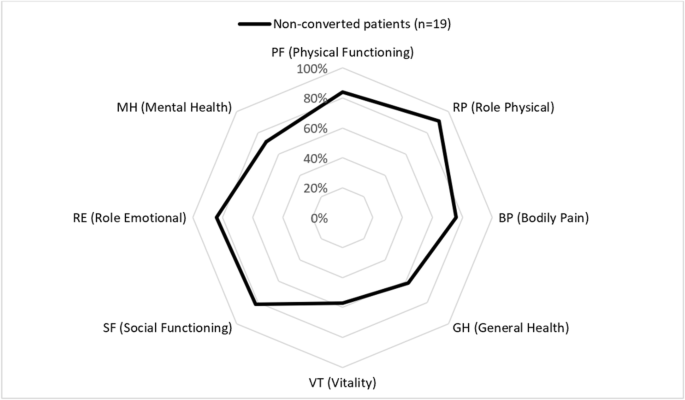
Brusque Form 36 (SF-36) in non-converted patients 15 years subsequently sleeve gastrectomy
Discussion
This multicenter study presents a follow-up of at least xv years after SG in terms of weight loss, conversion rate, remission of AMP, QOL, and data from bariatric-metabolic outcome scores. To the authors' best noesis, this written report represents the longest follow-up after SG in the literature so far with a high follow-upwards rate. As mentioned before, this report is an update of the exact aforementioned patient collective published 5 years agone, which presented a follow-upwards of 10 years subsequently SG [13]. Therefore, the current report is well-suited to compare the effect at both points in time and to track a tendency in the long-term follow-up.
Conversion Rate and Weight loss
Information on a long-term outcome of more than 10 years focusing on weight loss after SG are rare in the literature. Withal, comparing this written report'southward information (fifteen years follow-up) to the previous study with a 10-year follow-up, an interesting trend may be observed. Long-term weight loss remains stable or even decreases, however, does so at the cost of a college conversion rate. To be exact, mean weight of the total commonage decreases from 98.one (after 10 years) to 92.4kg (later 15 years), whereas the conversion rate increases from 35.8 (later on 10 years) to 49.1%. This shift of patients with weight regain from the non-converted group to the converted group with farther weight loss leads to meliorate results in both groups. Also, the hateful EWL of the total collective increases from 54.0 (later on 10 years) to 61.0% (after 15 years). The high number of additional conversions within the last 5 years was, in a mode of speaking, in role caused by our previous study [13]. As patients were invited to our bariatric center, those suffering from weight regain and/or reflux, who might not take been inclined to do so otherwise, asked for solutions to cure their condition. Some of them ended up being converted; however, none of them were in any way urged to make this determination. Additionally, it must be considered that patients in the converted group had at least two bariatric-metabolic operations.
In that location is a small number of studies on SG with a follow-upward of at to the lowest degree 10 years available in the literature today. Chang D.M. et al. presented 65 patients afterwards SG that reached a long-term follow-up of 10 years. The authors report an EWL of seventy.5% with a low conversion rate of only sixteen.9%; however, the follow-upward charge per unit was simply 64.four% [9]. Some other study of 110 patients afterwards SG with 11.seven years follow-up by Arman 1000.A. et al. reported an EWL of 62.5%, which is equal to the data found in the present report. The conversion rate was 25.0%, merely a low patient follow-up charge per unit of only 59.1% was reached. Castagneto Gissey L. et al. presented their 114 patients 10–11 years after SG with quite a high follow-up rate of 77%. Their outcomes were an EWL of 52.5%, which is comparable to our previously published study [13] and a very low conversion rate indeed of only ii% [8].
Information technology may be summarized that long-term studies after SG showed a relatively stable weight and acceptable weight loss charge per unit, and an increasing conversion rate over time.
Remission of Associated Medical Bug
The electric current study presents the first remission rates and rates of new onsets of AMP at more than 15 years later SG. Notwithstanding, the description is based on a relatively small population every bit only 29.5% of the patients had at least one associated medical problem at the time of the SG. Therefore, the validity of the data based on AMP is express.
Regardless of the small population, the improvement rates are relatively stable over time with only small numbers of new onsets compared to our 10-year effect report [13]. This has to be seen as an achievement as this patient population is at to the lowest degree 15 years older than their mean age at the time of the SG, especially considering the fact that the college the historic period of the patient, the more probable they are to develop new AMP.
Also, the remission rates of AMP afterwards SG in other long term-studies with a follow-upward of more than ten years are based on small patient populations as well. In terms of DMII remission, rates betwixt 39.1 by Chang D.M. et al. [nine] and 64.seven% by Castagneto Gissey L. et al. [8] after 10 years are reported. The remission rates of AH differ the most in the long-term follow-up in the literature: from 28.6 reported by Arman M.A. et al. [11] later on xi.7 years to up to 78.4% after x years past Chang D.M. et al. [9]. The reported HL remission rates are 36.four% [eight], 40.0% [11], and 51.3% [9], and remission rates of OSA are 66.0% [eleven] and 72.2% [8]. It should exist noted, withal, that the reported values are competitive rates of both converted and non-converted patients and therefore data does not exclusively reflect the long-term consequence later on non-converted SG.
Information technology tin exist summarized that acceptable to adept remission rates of AMP subsequently SG still exist later on a long follow-up menstruation of 10–15 years. Nevertheless, these outcomes are based on rather weak data due to pocket-sized study cohorts. For more reliable information, the publication of randomized control trials (SM-BOSS and SLEEVEPASS) on long-term outcomes after SG has to be awaited—they currently report mid-term outcomes [xx].
Outcome and Quality of Life
The following QOL and result scores were used in the current study: BAROS as an issue score afterward bariatric-metabolic procedures, BQL equally a QOL questionnaire specifically created for patients with obesity after a bariatric-metabolic process, and SF-36 equally a general QOL questionnaire reflecting a bigger pic of patients' psychological and physical QOL.
A comparison of the BAROS score in today'south report to the information gained from the score in our previously published written report 10 years afterward SG shows that this score has increased from 2.4 (10 years) to 2.9 (15 years) in non-converted patients later SG; notwithstanding, the nomenclature is still the same reflecting a fairly efficient issue. The reason for the increased score is simply based on the loftier conversion rate, equally patients converted due to weight regain were not included in this analysis and weight loss has a major bear on on this score. A recently published study by Fiorani C. et al. reported a BAROS of 1.47 at an 8-yr follow-upward after SG [21].
Comparison data gained from the BQL and SF-36 scores in this study and our x-twelvemonth follow-upwards shows a slight improvement from ten to 15 years subsequently SG in the BQL too every bit all viii categories of the SF-36 [19]. Again, this outcome reflects that weight regain and reflux have a major impact on patients' QOL and, therefore, a conversion to RYGB may meliorate their QOL, if at to the lowest degree one of these side effects exists.
A recent study by Major P. et al. reports SF-36 data in 28 SG patients earlier the performance, at 1 yr, and at 10 years after [22]. All viii categories improved significantly in the showtime year but re-decreased 10 years after SG. Nevertheless, at 10 years afterward SG, the SF-36 QOL was still majorly improved in all categories compared to the preoperative information. The results 10 years afterwards SG were very similar to those of our own study 10 years later on SG [xix].
To conclude, the best way to interpret patients' QOL is comparing ane patient collective'south data from different points in time, thus taking a longitudinal perspective. All the reported scores proved valid to work out the individual patient's QOL at different points in fourth dimension after SG.
Limitations of the Report
This study presents a minor collective from the showtime of SG as stand-alone procedure. The common performance technique has slightly changed since then, even though a worldwide standard does not exist, yet. To increase the number of patients, patients from other bariatric centers with the same operation technique at the fourth dimension were included; yet, the number of patients may still be too small to draw any final conclusions. Additionally, this also increases the number of surgeons who performed the procedure in these patients.
Another limitation is that 10 patients had gastric banding before SG, which may accept affected weight loss and outcome. However, it should be considered that patients with previous bariatric-metabolic procedures reflect the typical collective of patients bariatric surgeons deal with. Also, the size of the bougie used in SG has changed slightly, which may lead to unlike weight loss outcomes in recently operated SG patients.
Finally, the current written report lacks preoperative data on QOL; therefore, the collected data cannot be compared to patients' QOL before SG.
Conclusion
15 years afterwards SG, a skillful and stable postoperative weight was observed merely at the toll of a high conversion rate of upward to 49.i% due to weight regain and reflux. Patients converted to RYGB were able to attain further weight loss and preserve good remission rates of AMP. SG in patients without the need of a conversion to some other bariatric-metabolic process may be considered constructive. In determination, a careful preoperative patient selection is mandatory when performing SG in patients with obesity.
References
-
Collaborators GBDO, Afshin A, Forouzanfar MH, et al. Health effects of overweight and obesity in 195 countries over 25 years. Northward Engl J Med. 2017;377:13–27.
-
Welbourn R, Hollyman Grand, Kinsman R, et al. Bariatric surgery worldwide: baseline demographic description and one-year outcomes from the 4th IFSO global registry report 2018. Obes Surg. 2019;29:782–95.
-
Angrisani L, Santonicola A, Iovino P, et al. Bariatric surgery survey 2018: similarities and disparities among the 5 IFSO capacity. Obes Surg. 2021;31:1937–48.
-
Feng JJ, Gagner M. Laparoscopic biliopancreatic diversion with duodenal switch. Semin Laparosc Surg. 2002;9:125–9.
-
Regan JP, Inabnet WB, Gagner M, et al. Early on experience with ii-stage laparoscopic Roux-en-Y gastric bypass equally an culling in the super-super obese patient. Obes Surg. 2003;xiii:861–4.
-
Deitel M, Crosby RD, Gagner M. The first international consensus summit for sleeve gastrectomy (SG), New York City, Oct 25-27, 2007. Obes Surg. 2008;eighteen:487–96.
-
Bohdjalian A, Langer FB, Shakeri-Leidenmuhler Southward, et al. Sleeve gastrectomy equally sole and definitive bariatric procedure: 5-twelvemonth results for weight loss and ghrelin. Obes Surg. 2010;20:535–40.
-
Castagneto Gissey L, Casella Mariolo JR, Genco A, et al. 10-twelvemonth follow-upwardly after laparoscopic sleeve gastrectomy: outcomes in a monocentric serial. Surg Obes Relat Dis. 2018;fourteen:1480–vii.
-
Chang DM, Lee WJ, Chen JC, et al. 13-Year experience of laparoscopic sleeve gastrectomy: surgical risk, weight loss, and revision procedures. Obes Surg. 2018;28:2991–vii.
-
Felsenreich DM, Kefurt R, Schermann Grand, et al. Reflux, sleeve dilation, and Barrett's esophagus later laparoscopic sleeve gastrectomy: long-term follow-up. Obes Surg. 2017;27:3092–101.
-
Arman GA, Himpens J, Dhaenens J, et al. Long-term (11+years) outcomes in weight, patient satisfaction, comorbidities, and gastroesophageal reflux treatment after laparoscopic sleeve gastrectomy. Surg Obes Relat Dis. 2016;12:1778–86.
-
Felsenreich DM, Ladinig LM, Beckerhinn P, et al. Update: 10 years of sleeve gastrectomy-the first 103 patients. Obes Surg. 2018;28:3586–94.
-
Felsenreich DM, Langer FB, Kefurt R, et al. Weight loss, weight regain, and conversions to Roux-en-Y gastric bypass: 10-year results of laparoscopic sleeve gastrectomy. Surg Obes Relat Dis. 2016;12:1655–62.
-
Oria HE, Moorehead MK. Bariatric analysis and reporting outcome organisation (BAROS). Obes Surg. 1998;8:487–99.
-
Weiner S, Sauerland S, Fein M, et al. The bariatric quality of life index: a measure of well-being in obesity surgery patients. Obes Surg. 2005;15:538–45.
-
Weiner South, Sauerland S, Weiner R, et al. Validation of the adapted bariatric quality of life index (BQL) in a prospective written report in 446 bariatric patients as one-factor model. Obes Facts. 2009;two(Suppl 1):63–half-dozen.
-
Jenkinson C, Coulter A, Wright L. Brusque class 36 (SF36) health survey questionnaire: normative information for adults of working age. BMJ. 1993;306:1437–40.
-
Felsenreich DM, Bichler C, Langer FB, et al. Sleeve gastrectomy: surgical technique, outcomes, and complications. Surg Technol Int. 2020;36:63–nine.
-
Felsenreich DM, Prager G, Kefurt R, et al. Quality of life 10 years after sleeve gastrectomy: a multicenter study. Obes Facts. 2019;12:157–66.
-
Benaiges D, Climent East, Goday A, et al. Mid-term results of laparoscopic Roux-en-Y gastric bypass and laparoscopic sleeve gastrectomy compared-results of the SLEEVEPASS and SM-BOSS trials. Ann Transl Med. 2018;vi:S83.
-
Fiorani C, Coles SR, Kulendran M, et al. Long-term quality of life outcomes later laparoscopic sleeve gastrectomy and Roux-en-Y gastric featherbed-a comparative study. Obes Surg. 2020.
-
Major P, Stefura T, Dziurowicz B, et al. Quality of life 10 years afterward bariatric surgery. Obes Surg. 2020;30:3675–84.
Acknowledgements
Data direction was kindly supported by Steffi Rothe.
Funding
Open access funding provided past Medical Academy of Vienna.
Author information
Affiliations
Respective author
Ethics declarations
Informed Consent
Informed consent was obtained from each private participant included in the study.
Conflict of Interest
The authors declare no competing interests.
Man and Animal Rights
All procedures performed in studies involving man participants were in accordance with the ethical standards of the research committee of the Medical Academy of Vienna (EK 2169/2019) and with the 1964 Helsinki announcement and its after amendments or comparable upstanding standards. This article does non incorporate whatsoever studies with animals performed by any of the authors.
Additional information
Publisher's Annotation
Springer Nature remains neutral with regard to jurisdictional claims in published maps and institutional affiliations.
Key Points
• Fifteen years after SG, a adept and stable postoperative weight was observed but at the cost of a loftier conversion rate.
• SG in patients without the need of a conversion to another bariatric procedure may be considered successful.
• Patients converted to RYGB were able to accomplish further weight loss and preserve good remission rates of comorbidities.
• A conscientious preoperative patient selection is mandatory when performing SG in obese patients.
Rights and permissions
Open Admission This article is licensed under a Artistic Commons Attribution iv.0 International License, which permits apply, sharing, adaptation, distribution and reproduction in whatsoever medium or format, as long every bit you give appropriate credit to the original writer(s) and the source, provide a link to the Creative Eatables licence, and indicate if changes were made. The images or other third party material in this article are included in the article'southward Creative Commons licence, unless indicated otherwise in a credit line to the fabric. If material is not included in the commodity's Artistic Commons licence and your intended use is not permitted by statutory regulation or exceeds the permitted apply, yous will need to obtain permission directly from the copyright holder. To view a re-create of this licence, visit http://creativecommons.org/licenses/past/4.0/.
Reprints and Permissions
About this commodity
Cite this article
Felsenreich, D.Thou., Artemiou, E., Steinlechner, Grand. et al. Xv Years Later Sleeve Gastrectomy: Weight Loss, Remission of Associated Medical Issues, Quality of Life, and Conversions to Roux-en-Y Gastric Bypass—Long-Term Follow-Up in a Multicenter Report. OBES SURG 31, 3453–3461 (2021). https://doi.org/10.1007/s11695-021-05475-x
-
Received:
-
Revised:
-
Accepted:
-
Published:
-
Issue Date:
-
DOI : https://doi.org/10.1007/s11695-021-05475-10
Keywords
- Sleeve gastrectomy
- Weight regain
- Conversion
- Quality of life
- Roux-en-Y gastric featherbed
- Associated medical problems
Source: https://link.springer.com/article/10.1007/s11695-021-05475-x
0 Response to "I Had Roux and Y Gastric Bypass 15 Years Ago"
Post a Comment